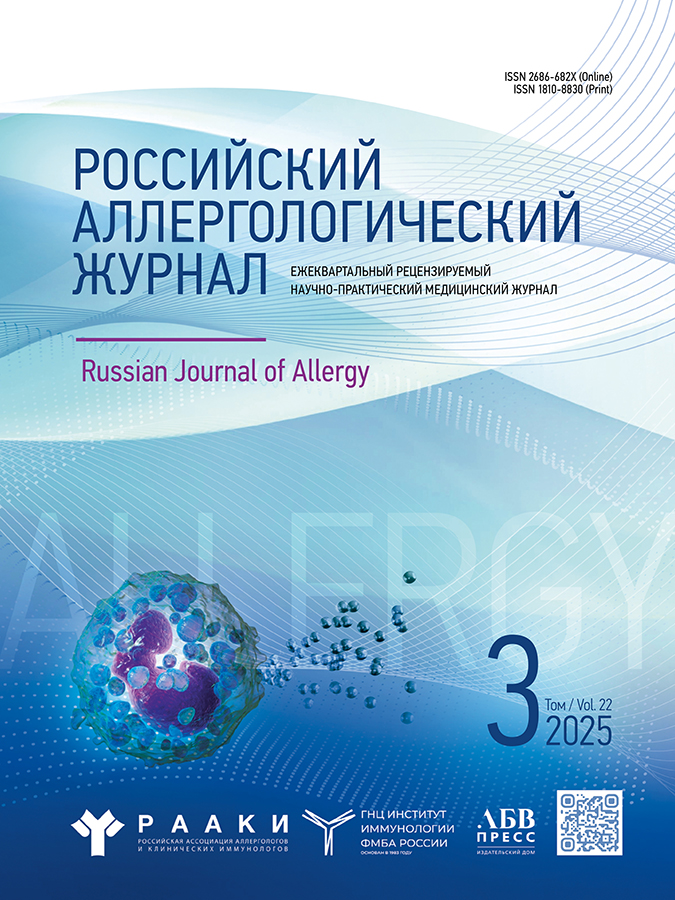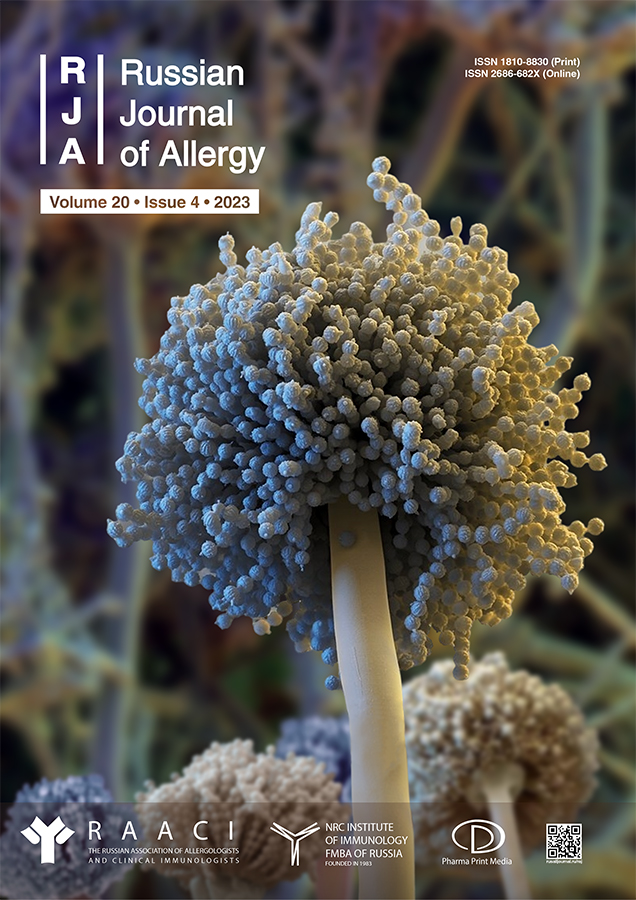Moisturizers for the treatment and prophylaxis of atopic dermatitis exacerbations
- Authors: Chernushevich D.D.1, Shtyrbul O.V.1, Grebenchenko E.I.1, Fedenko E.S.1
-
Affiliations:
- National Research Center ― Institute of Immunology Federal Medical-Biological Agency of Russia
- Issue: Vol 20, No 4 (2023)
- Pages: 549-555
- Section: Editorial
- Submitted: 31.10.2023
- Accepted: 07.11.2023
- Published: 02.12.2023
- URL: https://rusalljournal.ru/raj/article/view/16900
- DOI: https://doi.org/10.36691/RJA16900
- ID: 16900
Cite item
Abstract
Atopic dermatitis is a global problem with increasing prevalence. Genetic predisposition to allergies, epidermal barrier dysfunction, and T2 immune response underlie atopic dermatitis. Xerosis, itchy skin, and exacerbation are the main atopic dermatitis symptoms, leading to increased permeability of allergens and microbes through the damaged epidermis and to the development of sensitization. The main purpose of atopic dermatitis therapy is to achieve long-term remission and improve quality of life. Topical treatment includes glucocorticosteroids, topical calcineurin inhibitors, and emollients to reduce inflammation, xerosis, and infection prevention. Daily use of effective emollients as basic skin care can improve epidermal barrier function, provide skin hydration, and reduce the need for topical glucocorticosteroids.
Full Text
About the authors
Daria D. Chernushevich
National Research Center ― Institute of Immunology Federal Medical-Biological Agency of Russia
Email: chernushevitchdasha@yandex.ru
ORCID iD: 0000-0003-0006-2773
SPIN-code: 2497-5608
Россия, Moscow
Olga V. Shtyrbul
National Research Center ― Institute of Immunology Federal Medical-Biological Agency of Russia
Email: ovs-495@yandex.ru
ORCID iD: 0000-0001-8254-9715
SPIN-code: 4146-1788
MD, Cand. Sci. (Med.)
Россия, MoscowElena I. Grebenchenko
National Research Center ― Institute of Immunology Federal Medical-Biological Agency of Russia
Email: ghellena@mail.ru
ORCID iD: 0000-0002-0756-5464
SPIN-code: 6726-3997
MD, Cand. Sci. (Med.)
Россия, MoscowElena S. Fedenko
National Research Center ― Institute of Immunology Federal Medical-Biological Agency of Russia
Author for correspondence.
Email: efedks@gmail.com
ORCID iD: 0000-0003-3358-5087
SPIN-code: 5012-7242
MD, Dr. Sci. (Med.), Professor
Россия, MoscowReferences
- Maspero J, De Paula Motta Rubini N, Zhang J, et al. Epidemiology of adult patients with atopic dermatitis in AWARE 1: A second international survey. World Allergy Organ J. 2023;16(3):100724. doi: 10.1016/j.waojou.2022.100724
- Boguniewicz M, Fonacier L, Guttman-Yassky E, et al. Atopic dermatitis yardstick update. Ann Allergy Asthma Immunol. 2023;130(6):811–820. doi: 10.1016/j.anai.2023.03.010
- Kang SY, Um JY, Chung BY, et al. Moisturizer in patients with inflammatory skin diseases. Medicina (Kaunas). 2022;58(7):888. doi: 10.3390/medicina58070888
- Lee HH, Patel KR, Singam V, et al. A systematic review and meta-analysis of the prevalence and phenotype of adult-onset atopic dermatitis. J Am Acad Dermatol. 2019;80(6):1526–1532.e7. doi: 10.1016/j.jaad.2018.05.1241
- Abuabara K, Yu AM, Okhovat JP, et al. The prevalence of atopic dermatitis beyond childhood: A systematic review and meta-analysis of longitudinal studies. Allergy. 2018;73(3):696–704. doi: 10.1111/all.13320
- Langan SM, Irvine AD, Weidinger S. Atopic dermatitis. Lancet. 2020;396(10247):345–360. doi: 10.1016/S0140-6736(20)31286-1
- Aw M, Penn J, Gauvreau GM, et al. Atopic march: Collegium Internationale Allergologicum Update 2020. Int Arch Allergy Immunol. 2020;181(1):1–10. doi: 10.1159/000502958
- Hill DA, Spergel JM. The atopic march: Critical evidence and clinical relevance. Ann Allergy Asthma Immunol. 2018;120(2):131–137. doi: 10.1016/j.anai.2017.10.037
- Czarnowicki T, Krueger JG, Guttman-Yassky E. Novel concepts of prevention and treatment of atopic dermatitis through barrier and immune manipulations with implications for the atopic march. J Allergy Clin Immunol. 2017;139(6):1723–1734. doi: 10.1016/j.jaci.2017.04.004
- Aaron MD, Jordan MT, Wen-Qing L, et al. Incident alopecia areata and vitiligo in adult women with atopic dermatitis: Nurses’ health study 2. Allergy. 2017;72(5):831–834. doi: 10.1111/all.13128
- He H, Li R, Choi S, et al. Increased cardiovascular and atherosclerosis markers in blood of older patients with atopic dermatitis. Ann Allergy Asthma Immunol. 2020;124(1):70–78. doi: 10.1016/j.anai.2019.10.013
- Silverberg JI. Association between adult atopic dermatitis, cardiovascular disease, and increased heart attacks in three population-based studies. Allergy. 2015;70(10):1300–1308. doi: 10.1111/all.12685
- Andersen YM, Egeberg A, Gislason GH, et al. Autoimmune diseases in adults with atopic dermatitis. J Am Acad Dermatol. 2017;76(2):274–280.e1. doi: 10.1016/j.jaad.2016.08.047
- Ress K, Annus T, Putnik U, et al. Celiac disease in children with atopic dermatitis. Pediatr Dermatol. 2014;31(4):483–488. doi: 10.1111/pde.12372
- Schmitt J, Schwarz K, Baurecht H, et al. Atopic dermatitis is associated with an increased risk for rheumatoid arthritis and in"ammatory bowel disease, and a decreased risk for type 1 diabetes. J Allergy Clin Immunol. 2016;137(1):130–136. doi: 10.1016/j.jaci.2015.06.029
- Pónyai G, Hidvégi B, Németh I, et al. Contact and aeroallergens in adulthood atopic dermatitis. J Eur Acad Dermatol Venereol. 2008;22(11):1346–1355. doi: 10.1111/j.1468-3083.2008.02886.x
- Nankervis H, Pynn EV, Boyle RJ, et al. House dust mite reduction and avoidance measures for treating eczema. Cochrane Database Syst Rev. 2015;1(1):CD008426. doi: 10.1002/14651858.CD008426.pub2
- Werfel T, Heratizadeh A, Niebuhr M, et al. Exacerbation of atopic dermatitis on grass pollen exposure in an environmental challenge chamber. J Allergy Clin Immunol. 2015;136(1):96–103.e9. doi: 10.1016/j.jaci.2015.04.015
- Fölster-Holst R, Galecka J, Weißmantel S, et al. Birch pollen influence the severity of atopic eczema: Prospective clinical cohort pilot study and ex vivo penetration study. Clin Cosmet Investig Dermatol. 2015;(8):539–548. doi: 10.2147/CCID.S81700
- Beck LA, Cork MJ, Amagai M, et al. Type 2 inflammation contributes to skin barrier dysfunction in atopic dermatitis. JID Innov. 2022;2(5):100131. doi: 10.1016/j.xjidi.2022.100131
- Hon KL, Lam PH, Ng WG, et al. Age, sex, and disease status as determinants of skin hydration and transepidermal water loss among children with and without eczema. Hong Kong Med J. 2020;26(1):19–26. doi: 10.12809/hkmj198150
- Horimukai K, Morita K, Narita M, et al. Transepidermal water loss measurement during infancy can predict the subsequent development of atopic dermatitis regardless of filaggrin mutations. Allergol Int. 2016;65(1):103–108. doi: 10.1016/j.alit.2015.09.004
- Simpson EL, Chalmers JR, Hanifin JM, et al. Emollient enhancement of the skin barrier from birth offers effective atopic dermatitis prevention. J Allergy Clin Immunol. 2014;134(4):818–823. doi: 10.1016/j.jaci.2014.08.005
- Chaoimh NC, Lad D, Nico C, et al. Early initiation of short-term emollient use for the prevention of atopic dermatitis in high-risk infants: The STOP-AD randomised controlled trial. Allergy. 2023;78(4):984–994. doi: 10.1111/all.15491
- Czarnowicki T, Malajian D, Khattri S, et al. Petrolatum: Barrier repair and antimicrobial responses underlying this inert moisturizer. J Allergy Clin Immunol. 2016;137(4):1091–102.e1-7. doi: 10.1016/j.jaci.2015.08.013
- Spada F, Harrison IP, Barnes TM, et al. A daily regimen of a ceramide-dominant moisturizing cream and cleanser restores the skin permeability barrier in adults with moderate eczema: A randomized trial. Dermatol Ther. 2021;34(4):e14970. doi: 10.1111/dth.14970
- Subramanyan K. Role of mild cleansing in the management of patient skin. Dermatol Ther. 2004;17(Suppl 1):26–34. doi: 10.1111/j.1396-0296.2004.04S1003.x
- Litovkina AO, Smolnikov EV, Elisyutina OG, Fedenko ES. Modern emollients in the prevention of exacerbations of atopic dermatitis in the season of flowering. Russ J Allergol. 2023;20(1):41–51. (In Russ). doi: 10.36691/RJA4136
- Kubanov AA, Namazova-Baranova LS, Khaitov RM, et al. Atopic dermatitis. Clinical recommendations. Russ Allergol J. 2021;18(3):44–92. (In Russ). doi: 10.36691/RJA1474
Supplementary files




